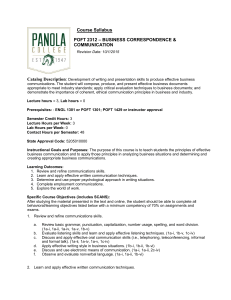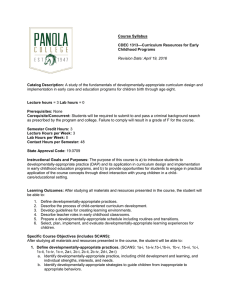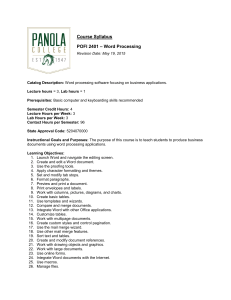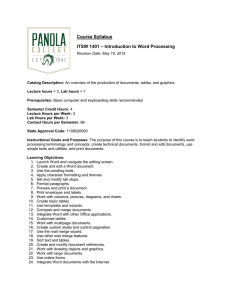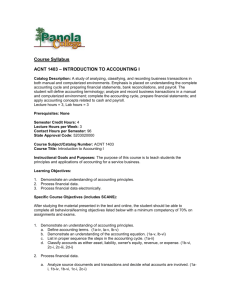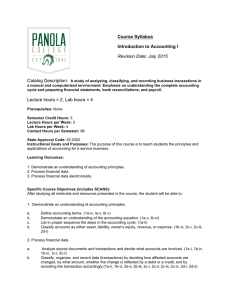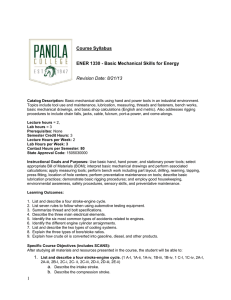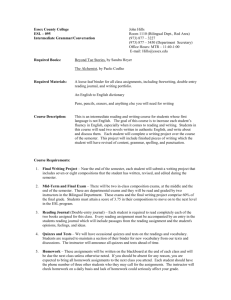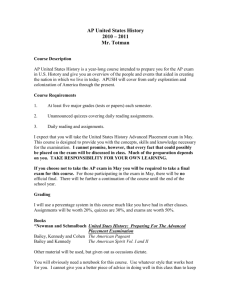Course Syllabus MRKG 1311 – Principles of Marketing
advertisement
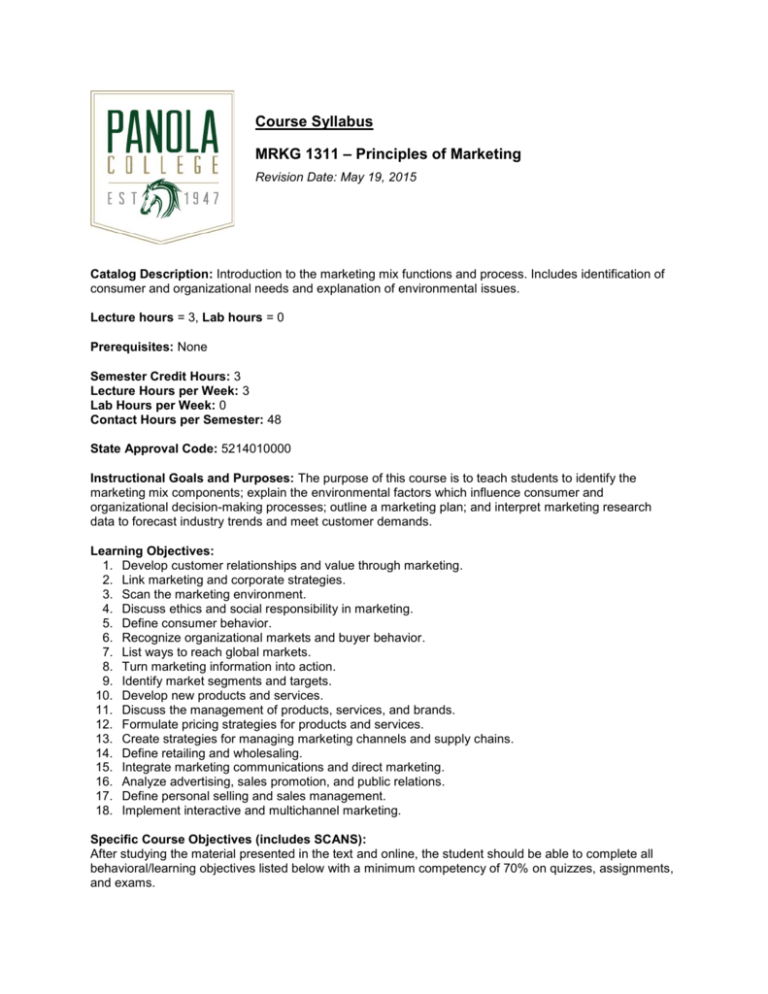
Course Syllabus MRKG 1311 – Principles of Marketing Revision Date: May 19, 2015 Catalog Description: Introduction to the marketing mix functions and process. Includes identification of consumer and organizational needs and explanation of environmental issues. Lecture hours = 3, Lab hours = 0 Prerequisites: None Semester Credit Hours: 3 Lecture Hours per Week: 3 Lab Hours per Week: 0 Contact Hours per Semester: 48 State Approval Code: 5214010000 Instructional Goals and Purposes: The purpose of this course is to teach students to identify the marketing mix components; explain the environmental factors which influence consumer and organizational decision-making processes; outline a marketing plan; and interpret marketing research data to forecast industry trends and meet customer demands. Learning Objectives: 1. Develop customer relationships and value through marketing. 2. Link marketing and corporate strategies. 3. Scan the marketing environment. 4. Discuss ethics and social responsibility in marketing. 5. Define consumer behavior. 6. Recognize organizational markets and buyer behavior. 7. List ways to reach global markets. 8. Turn marketing information into action. 9. Identify market segments and targets. 10. Develop new products and services. 11. Discuss the management of products, services, and brands. 12. Formulate pricing strategies for products and services. 13. Create strategies for managing marketing channels and supply chains. 14. Define retailing and wholesaling. 15. Integrate marketing communications and direct marketing. 16. Analyze advertising, sales promotion, and public relations. 17. Define personal selling and sales management. 18. Implement interactive and multichannel marketing. Specific Course Objectives (includes SCANS): After studying the material presented in the text and online, the student should be able to complete all behavioral/learning objectives listed below with a minimum competency of 70% on quizzes, assignments, and exams. 1. Develop customer relationships and value through marketing. (1a-i, 1a-ii, 1a-iv, 1b-i, 1b-ii, 1biii, 1b-iv, 1b-vi, 1c-v, 2c-i, 2c-ii, 2c-iii, 2c-iv) a. Define marketing and explain the importance of discovering and satisfying consumer needs and wants. b. Distinguish between marketing mix elements and environmental factors. c. Describe how organizations build strong customer relationships using current thinking about customer value and relationship marketing. d. Explain the meaning of ethics and social responsibility and how they relate to the individual, organizations, and society. 2. Link marketing and corporate strategies. (1a-i, 1a-ii, 1a-iv, 1b-i, 1b-ii, 1b-iii, 1b-iv, 1b-vi, 2c-i, 2c-ii, 2c-iii, 2c-iv) a. Describe the three organizational levels of strategy and how they relate to each other and the marketing function. b. Describe why business, mission, culture, and goals are important in organizations. c. Explain how organizations set strategic directions by assessing where they are now and seek to be in the future. d. Describe the strategic marketing process and its three key phases: planning, implementation, and control. e. Explain how the marketing mix elements are blended into a marketing program. f. Describe how marketing control compares actual results with planned objectives and acts on deviations from the plan. 3. Scan the marketing environment. (1a-i, 1a-ii, 1a-iv, 1b-i, 1b-ii, 1b-iii, 1b-iv, 1b-vi, 2c-i, 2c-ii, 2c-iii, 2c-iv) a. Describe how environmental scanning provides information about social, economic, technological, competitive, and regulatory forces. b. Explain how social forces such as demographics and culture and economic forces such as macroeconomic conditions and consumer income affect marketing. c. Describe how technological changes can affect marketing. d. Summarize the forms of competition that exist in a market, key components of competition, and the impact of competition on corporate structures. e. Explain the major legislation that ensures competition and regulates the elements of the marketing mix. 4. Discuss ethics and social responsibility in marketing. (1a-i, 1a-ii, 1a-iv, 1b-i, 1b-ii, 1b-iii, 1b-iv, 1b-vi, 1c-v, 2c-i, 2c-ii, 2c-iii, 2c-iv) a. Explain the significance of ethics in marketing. b. Differentiate between legal and ethical behavior in marketing. c. Identify factors that influence ethical and unethical marketing decisions. d. Distinguish among the different concepts of ethics and social responsibility. 5. Define consumer behavior. (1a-i, 1a-ii, 1a-iv, 1b-i, 1b-ii, 1b-iii, 1b-iv, 1b-vi, 2c-i, 2c-ii, 2c-iii, 2c-iv) a. Outline the stages in the consumer decision process. b. Distinguish among three variations of the consumer decision process: routine, limited, and extended. c. Explain how psychological influences affect consumer behavior, particularly purchase decision processes. d. Identify major sociocultural influences on consumer behavior and their effects on purchase decisions. e. Recognize how marketers can use knowledge of consumer behavior to better understand and influence individual and family purchases. 6. Recognize organizational markets and buyer behavior. (1a-i, 1a-ii, 1a-iv, 1b-i, 1b-ii, 1b-iii, 1b-iv, 1b-vi, 2c-i, 2c-ii, 2c-iii, 2c-iv) a. Distinguish among industrial, reseller, and government markets. b. Recognize key characteristics of organizational buying that make it different from consumer buying. c. Explain how buying centers and buying situations influence organizational purchasing. d. Recognize the growing importance of online buying in industrial, reseller, and government markets. 2 7. List ways to reach global markets. (1a-i, 1a-ii, 1a-iv, 1b-i, 1b-ii, 1b-iii, 1b-iv, 1b-vi, 2c-i, 2c-ii, 2c-iii, 2c-iv) a. Explain the effects of economic protectionism and the implications of economic integration for global marketing practices. b. Recognize the importance of environmental factors (cultural, economic, and political) in shaping global marketing efforts. c. Describe different approaches firms use to enter and compete in global markets. d. Identify specific challenges marketers face when crafting worldwide marketing programs. 8. Turn marketing information into action. (1a-i, 1a-ii, 1a-iii, 1a-iv, 1b-i, 1b-ii, 1b-iii, 1b-v, 1b-iv, 1bvi, 2c-i, 2c-ii, 2c-iii, 2c-iv) a. Identify a four-step marketing research approach leading to marketing actions. b. Describe how secondary and primary data are used in marketing, including the uses of questionnaires, observations, experiments, and panels. c. Identify and correct typical problems in designing questions for a questionnaire. d. Explain how information technology enables information systems to be used to link massive amounts of marketing information to meaningful marketing actions. e. Recognize alternative methods to forecast sales and use the lost-horse and linear trend extrapolation methods to make a simple forecast. 9. Identify market segments and targets. (1a-i, 1a-ii, 1a-iv, 1b-i, 1b-ii, 1b-iii, 1b-iv, 1b-vi, 2c-i, 2c-ii, 2c-iii, 2c-iv) a. Explain what market segmentation is, when to use it, and the five steps involved in segmentation. b. Recognize the different factors used to segment consumer and organizational markets. c. Demonstrate the significance of heavy users in targeting markets. d. Develop a market-product grid to use in segmenting and targeting a market. e. Describe how marketing managers position products in the marketplace. 10. Develop new products and services. (1a-i, 1a-ii, 1a-iv, 1b-i, 1b-ii, 1b-iii, 1b-iv, 1b-vi, 2c-i, 2c-ii, 2ciii, 2c-iv) a. Identify the ways consumer and business goods and services are classified and marketed. b. Explain the effects of different ways of viewing "newness" in new products and services. c. Analyze the factors that contribute to the success or failure of a product or service. d. Describe the purposes of each step of the new-product process. 11. Discuss the management of products, services, and brands. (1a-i, 1a-ii, 1a-iv, 1b-i, 1b-ii, 1b-iii, 1b-iv, 1b-vi, 2c-i, 2c-ii, 2c-iii, 2c-iv) a. Explain the product life-cycle concept and relate a marketing strategy to each stage. b. Recognize the differences in product life cycles for various products and their implications for marketing decisions. c. List different approaches to managing a product's life cycle. d. Describe elements of brand personality and brand equity and the criteria for the good brand name. e. Explain the reason for different branding strategies employed by companies. f. Recognize the role of packaging and labeling in the marketing of a product. 12. Formulate pricing strategies for products and services. (1a-i, 1a-ii, 1a-iii, 1a-iv, 1b-i, 1b-ii, 1b-iii, 1b-iv, 1b-vi, 2c-i, 2c-ii, 2c-iii, 2c-iv) a. Identify the elements that make up a price. b. Differentiate among demand-oriented, cost-oriented, profit-oriented, and competition-oriented approaches to pricing and the major factors considered in arriving at a final list of quoted price. c. Explain what a demand curve is and what price elasticity of demand means. d. Explain the role of revenues (sales) and costs in pricing decisions. e. Use break-even analysis. f. Recognize the objectives a firm has in setting prices and the constraints on the range of prices a firm can charge. g. Describe the special adjustments made to the approximate price level on the basis of geography, discounts, and allowances. 3 13. Create strategies for managing marketing channels and supply chains. (1a-i, 1a-ii, 1a-iv, 1b-i, 1b-ii, 1b-iii, 1b-iv, 1b-vi, 2c-i, 2c-ii, 2c-iii, 2c-iv) a. Explain what is meant by a marketing channel of distribution and why intermediaries are needed. b. Recognize differences between marketing channels for consumer and business products and services, and between different types of vertical marketing systems. c. Describe factors considered by marketing executives when selecting and managing a marketing channel. d. Explain what supply chain and logistic management are and how they relate to marketing strategy. e. Explain how managers trade off different "logistics costs" relative to customer service in order to make a supply chain decision. 14. Define retailing and wholesaling. (1a-i, 1a-ii, 1a-iv, 1b-i, 1b-ii, 1b-iii, 1b-iv, 1b-vi, 2c-i, 2c-ii, 2c-iii, 2c-iv) a. Identify retailers in terms of the utilities they provide. b. Explain the alternative ways to classify retail outlets. c. List various methods of nonstore retailing. d. Develop retailing mix strategies over the life cycle of a retail store. e. Describe the types and functions of firms that perform wholesaling activities. 15. Integrate marketing communications and direct marketing. (1a-i, 1a-ii, 1a-iv, 1b-i, 1b-ii, 1b-iii, 1b-iv, 1b-vi, 2c-i, 2c-ii, 2c-iii, 2c-iv) a. Explain the communication process and its elements. b. Describe the promotional mix and the uniqueness of each component. c. Select the promotional approach appropriate to a product's life-cycle stage. d. Differentiate between the advantages of push and pull strategies. e. Explain the value of an integrated marketing communications approach. f. Recognize the value of direct marketing for consumers and sellers. 16. Analyze advertising, sales promotion, and public relations. (1a-i, 1a-ii, 1a-iv, 1b-i, 1b-ii, 1b-iii, 1b-iv, 1b-vi, 2c-i, 2c-ii, 2c-iii, 2c-iv) a. Explain the differences between product advertising and institutional advertising and the variations within each type. b. List the steps used to develop, execute, and evaluate an advertising program. c. Explain the advantages and disadvantages of alternative advertising media. d. Explain the strengths and weaknesses of consumer-oriented and trade-oriented sales promotions. e. Recognize public relations as an important form of communication. 17. Define personal selling and sales management. (1a-i, 1a-ii, 1a-iv, 1b-i, 1b-ii, 1b-iii, 1b-iv, 1b-vi, 2c-i, 2c-ii, 2c-iii, 2c-iv) a. Recognize different types of personal selling. b. Describe the stages in the personal selling process. c. Specify the functions and tasks in the sales management process. d. Explain how firms recruit, select, train, motivate, compensate, and evaluate salespeople. e. Describe recent applications of sales force automation and customer relationship management. 18. Implement interactive and multichannel marketing. (1a-i, 1a-ii, 1a-iv, 1b-i, 1b-ii, 1b-iii, 1b-iv, 1bvi, 2c-i, 2c-ii, 2c-iii, 2c-iv) a. Define interactive marketing and explain how it creates customer value, customer relationships, and customer experiences in the new marketspace. b. Explain why certain types of products and services are particularly suited for interactive marketing. c. Describe why consumers shop and buy online and how marketers influence online purchasing behavior. d. Distinguish between the use of multiple channels and multichannel marketing in reaching online consumers. e. Recognize the different roles played by transactional websites and promotional websites in multichannel marketing. 4 Course Content: Students in all sections of Principles of Marketing will be required to do the following: 1. Students will complete various assignments throughout the semester such as assessing a marketing plan or campaign, completing a SWOT analysis, evaluating advertisements using various media, reviewing marketing-related articles, etc. All of these assignments will be submitted through Canvas. 2. Students will complete an online quiz for each chapter evaluating the following: the marketing concept, the marketing mix, monitoring the external and internal environment, ethics and social responsibility, consumer and organizational buying behavior, identifying target markets and segments, branding, pricing, distribution channels, marketing media, etc. 3. Students will complete online objective exams in the presence of a testing proctor. Methods of Instruction/Course Format/Delivery: This course is offered in the traditional classroom and over the Internet. Students in the traditional class and in the Internet class will have access to this course via Canvas, a learning management system. Students in the traditional class will meet regularly for lecture over the material. Students in the Internet class will only be required to meet with the instructor for testing; however, Internet students are always welcome to attend the traditional class (especially for exam reviews). All quizzes, assignments, and exams will be submitted through Canvas. After an assignment has been graded, the student will be able to view his or her grade by returning to the exercise or by clicking the Grades link in the left banner. Students will have limited review of the answers to the exams, but they will always be able to view the score. Your work will normally be graded and posted within two days following the deadline. Students in both the traditional and Internet classes should use e-mail within Canvas to communicate with the instructor. Using Canvas email gives you access to the instructor and other classmates without having to remember or type email addresses—you just select a name from the list. If you are not able to contact your instructor using email in Canvas, you may use his or her Panola College email address. Panola College instructors attempt to respond to all email within 24 hours. Please always include a subject line and your name in your email. Assessment: The following items will be assigned during the semester and used to calculate the student’s final grade: ASSIGNMENTS Periodically throughout the semester, you will be asked to download and complete short exercises. You may be asked to complete an analysis of a company, review an article, view a video, examine a company's marketing techniques, etc. All assignments must be completed and submitted before a set deadline. QUIZZES Approximately 10 quizzes will be given during the semester. The quizzes will be given online and you may use your textbook to complete them. Each quiz will have a deadline and failure to complete the quiz by the deadline will result in a zero for that quiz. The normal quiz includes ten multiple choice questions; incorrect answers will count 10 points each. Your two lowest quiz grades will be dropped at the end of the semester. EXAMS Approximately four exams will be given this semester. Each of the exams will be online and will be taken in the presence of a proctor at the Carthage, Center, or Marshall sites. Virtual College of Texas (VCT) students will be able to take proctored exams at the college they currently attend. If you are unable to take a test when it is scheduled, you must reschedule the test with the instructor prior to the testing date. An excused absence and makeup test may be granted for sudden illness or unforeseen circumstances. 5 Course Grade: The grading scale for this course is as follows: Assignments – 20% Quizzes – 20% Exams – 60% All student grades including a mid-semester and final grade will be posted to Grades in Canvas. Cheating is defined as unauthorized help on an examination or assigned course material. A student must not submit another student’s work as his or her own. A student must not receive from any other student or give to any other student any information, answers, or help during an exam. A student must not "steal" the answers from an unsuspecting student during an exam. A student must not use any sources for answers during an exam (including but not limited to notes, books, or electronic devices) without prior authorization from the professor. A student must not obtain exam questions illegally, tamper with the exam questions, nor change the results of an exam after it has been graded. All cheating infractions will result in a grade of “0” for the assignment. Plagiarism is defined as the taking of a person's ideas, words, or information and claiming those properties as one's own. The use of all ideas, words, or information from any source must be properly referenced and due credit must be given to its author. All written assignments must be submitted through Canvas which uses turnitin.com to calculate percent originality of the submission. For compositions, a student’s work must show 0% plagiarism. For research assignments, properly quoting and citing information from other sources is usually required in the assignment; however, since the integrity of the assignment is based upon the originality of the student's work, no student may turn in a paper which exceeds a 30% score in properly quoted and cited material. The instructor reserves the right to employ other means outside of turnitin.com to check the "originality" of a students work. Any submission that contains copied material (other than cited material in a research paper) will automatically receive a grade of "0" for the assignment. A student will fail the class upon his or her second cheating and/or plagiarism offense. These policies shall be adhered to unless mitigating circumstances should prove a lesser penalty should apply. Students shall have the right to contest a cheating or plagiarism claim; the appeals process is specifically defined in the student handbook. Attendance: Students in the face-to-face class are expected to arrive on time and remain in class until the class is over as random movement into, out of, or around the classroom is disruptive and disrespectful. Students are highly encouraged to participate in class by asking questions and engaging in discussions. Disruptive class behavior will result in dismissal from the classroom and an absent mark on the attendance record. Persistent, disruptive behavior may ultimately result in dismissal from the course, a failing grade, and further disciplinary actions in accordance with college policy. Make up assignments/exams will only be granted in accord with the excused absence policy. A student that chooses to NOT finish the course must complete the withdrawal procedure in the Student Success office in order to receive a “W.” Otherwise, the student will receive a grade at the end of the semester commensurate with the work completed. Students needing special classroom or testing accommodations because of physical or learning disabilities must contact the Student Success office before these services will be made available in the classroom. Texts, Materials, and Supplies: Marketing, 12th edition (looseleaf), Kerin, Hartley, and Rudelius, McGraw-Hill Irwin, 2015, ISBN: 9780077861032. Access to a computer, a word processor, and the Internet. 6 Other: For current texts and materials, use the following link to access bookstore listings: http://www.panolacollegestore.com. For testing services, use the following link: http://www.panola.edu/elearning/testing.html. If any student in this class has special classroom or testing needs because of a physical learning or emotional condition, please contact the ADA Student Coordinator in Support Services located in the Administration Building or go to http://www.panola.edu/student-success/disability-supportservices/ for more information. Withdrawing from a course is the student’s responsibility. Students who do not attend class and who do not withdraw will receive the grade earned for the course. Student Handbook, The Pathfinder: http://www.panola.edu/studentsuccess/documents/pathfinder.pdf 7 SCANS CRITERIA 1) Foundation skills are defined in three areas: basic skills, thinking skills, and personal qualities. a) Basic Skills: A worker must read, write, perform arithmetic and mathematical operations, listen, and speak effectively. These skills include: i) Reading: locate, understand, and interpret written information in prose and in documents such as manuals, graphs, and schedules. ii) Writing: communicate thoughts, ideas, information, and messages in writing, and create documents such as letters, directions, manuals, reports, graphs, and flow charts. iii) Arithmetic and Mathematical Operations: perform basic computations and approach practical problems by choosing appropriately from a variety of mathematical techniques. iv) Listening: receive, attend to, interpret, and respond to verbal messages and other cues. v) Speaking: Organize ideas and communicate orally. b) Thinking Skills: A worker must think creatively, make decisions, solve problems, visualize, know how to learn, and reason effectively. These skills include: i) Creative Thinking: generate new ideas. ii) Decision Making: specify goals and constraints, generate alternatives, consider risks, and evaluate and choose the best alternative. iii) Problem Solving: recognize problems and devise and implement plan of action. iv) Visualize ("Seeing Things in the Mind's Eye"): organize and process symbols, pictures, graphs, objects, and other information. v) Knowing How to Learn: use efficient learning techniques to acquire and apply new knowledge and skills. vi) Reasoning: discover a rule or principle underlying the relationship between two or more objects and apply it when solving a problem. c) Personal Qualities: A worker must display responsibility, self-esteem, sociability, selfmanagement, integrity, and honesty. i) Responsibility: exert a high level of effort and persevere toward goal attainment. ii) Self-Esteem: believe in one's own self-worth and maintain a positive view of oneself. iii) Sociability: demonstrate understanding, friendliness, adaptability, empathy, and politeness in group settings. iv) Self-Management: assess oneself accurately, set personal goals, monitor progress, and exhibit self-control. v) Integrity and Honesty: choose ethical courses of action. 2) Workplace competencies are defined in five areas: resources, interpersonal skills, information, systems, and technology. a) Resources: A worker must identify, organize, plan, and allocate resources effectively. i) Time: select goal-relevant activities, rank them, allocate time, and prepare and follow schedules. ii) Money: Use or prepare budgets, make forecasts, keep records, and make adjustments to meet objectives. iii) Material and Facilities: Acquire, store, allocate, and use materials or space efficiently. Examples: construct a decision time line chart; use computer software to plan a project; prepare a budget; conduct a cost/benefits analysis; design an RFP process; write a job description; develop a staffing plan. b) Interpersonal Skills: A worker must work with others effectively. i) Participate as a Member of a Team: contribute to group effort. ii) Teach Others New Skills. iii) Serve Clients/Customers: work to satisfy customer's expectations. 8 iv) Exercise Leadership: communicate ideas to justify position, persuade and convince others, responsibly challenge existing procedures and policies. v) Negotiate: work toward agreements involving exchange of resources, resolve divergent interests. vi) Work with Diversity: work well with men and women from diverse backgrounds. Examples: collaborate with a group member to solve a problem; work through a group conflict situation, train a colleague; deal with a dissatisfied customer in person; select and use appropriate leadership styles; use effective delegation techniques; conduct an individual or team negotiation; demonstrate an understanding of how people from different cultural backgrounds might behave in various situations. c) Information: A worker must be able to acquire and use information. i) Acquire and Evaluate Information. ii) Organize and Maintain Information. iii) Interpret and Communicate Information. iv) Use Computers to Process Information. Examples: research and collect data from various sources; develop a form to collect data; develop an inventory record-keeping system; produce a report using graphics; make an oral presentation using various media; use on-line computer data bases to research a report; use a computer spreadsheet to develop a budget. d) Systems: A worker must understand complex interrelationships. i) Understand Systems: know how social, organizational, and technological systems work and operate effectively with them. ii) Monitor and Correct Performance: distinguish trends, predict impacts on system operations, diagnose deviations in systems' performance and correct malfunctions. iii) Improve or Design Systems: suggest modifications to existing systems and develop new or alternative systems to improve performance. Examples: draw and interpret an organizational chart; develop a monitoring process; choose a situation needing improvement, break it down, examine it, propose an improvement, and implement it. e) Technology: A worker must be able to work with a variety of technologies. i) Select Technology: choose procedures, tools or equipment including computers and related technologies. ii) Apply Technologies to Task: understand overall intent and proper procedures for setup and operation of equipment. iii) Maintain and Troubleshoot Equipment: Prevent, identify, or solve problems with equipment, including computers and other technologies. Examples: read equipment descriptions and technical specifications to select equipment to meet needs; set up and assemble appropriate equipment from instructions; read and follow directions for troubleshooting and repairing equipment. 9
